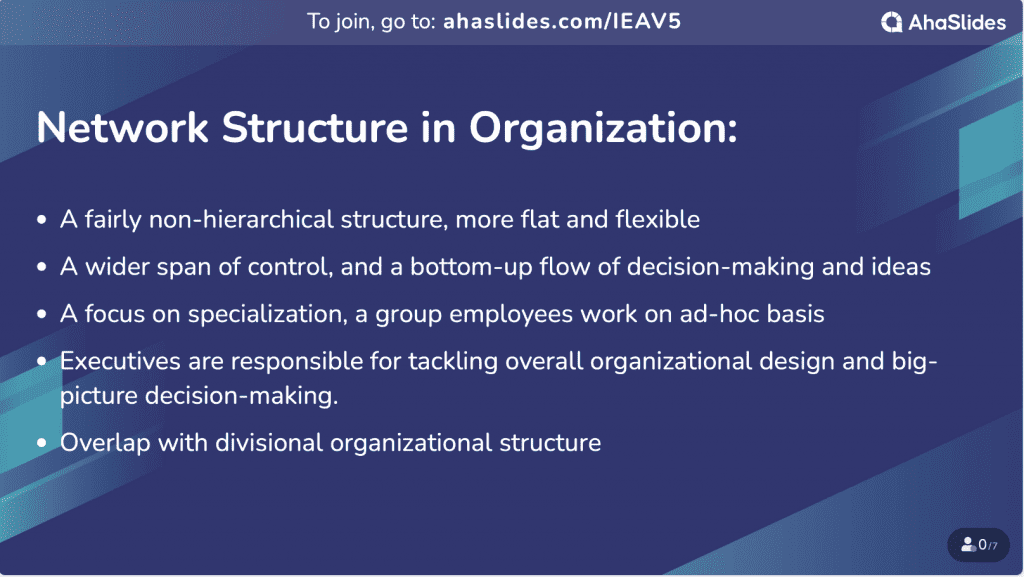When the hierarchical organizational structure is no longer suitable for companies to handle the rapid and ongoing changes of the market, network structure, a more decentralized operation, and many benefits, surely thrive. In particular, a lot of startups operate in this way.
This newer organizational structure is used widely nowadays, but the whole concept seems so strange to almost everyone. So what is Network Structure in Organization, its advantages and disadvantages? Let's take a look at this article!
| An example of a company that uses a network structure in organization? | H&M (Hennes & Mauritz) |
| How many types of Network Organizational Structures? | 4, including Integrated network, Correlated network, Contract network, and Direct relations network. |
Table of Contents
- What is Network Structure in Organization?
- What are the Characteristics of Network Structure in Organization?
- 4 Types of Network Organizational Structure
- What are Examples of Network Structure in Organization?
- Advantages of Network Structure in Organization
- Overcome the Limitations of Network Organizational Structure
- Frequently Asked Questions

Looking for More Fun During Gatherings?
Gather your team members by a fun quiz on AhaSlides. Sign up to take free quiz from AhaSlides template library!
🚀 Grab Free Quiz☁️
What is Network Structure in Organization?
Network structure is described as less hierarchical, more decentralized, and more flexible than other organizational structures.
It is the organizational structure type where there is an involvement of interacting with internal and external parties to deliver a product or service. Thus, managers coordinate and manage relations or networks that are both internal and external to the firm, and the chain of command runs through a cascading line of middle managers.
Within the network structure in organization, there is a more complicated series of relationships to which each individual should be connected:
- Vertical: involves status relationships (boss/employee)
- Horizontal: indicates to task relationships (colleague/co-worker)
- Initiative/Assignment-centric: refers to the formation and operation of temporary teams to work on certain purposes and then disband
- 3rd party relationships: refer to the relationship with vendors or subcontractors that are not permanent members of the organization
- Partnerships: are the collaboration with other organizations or outsources to share the benefit of both parties.
Furthermore, the virtual network approach should be noted as well. A virtual organization is a special type of Network structure that works temporarily. When the project is over, a virtual network is also gone. There is not only one leader firm.

What are the Characteristics of Network Structure in Organization?

- A fairly non-hierarchical structure: As mentioned, network structure in organization is viewed as less structured and relatively flat. Decision-making authority is often distributed across the network rather than concentrated at the top.
- A strong affinity for outsourcing: Organizations with a network structure often embrace outsourcing and partnerships, when they need a specific skill, function, and resource. It can be customer service, PR, or mechanical engineering.
- More agile structure: Because it is decentralized, a network structure in organization has fewer tiers, a wider span of control, and a bottom-up flow of decision-making and ideas.
- A focus on specialization: Different entities within the network specialize in specific functions or tasks. When there is a new project, certain types of employees are grouped together on an ad-hoc basis based on a common specialization.
- Lean Central Leadership: Executives are responsible for tackling overall organizational design and big-picture decision-making. However, empowered leaders try to avoid unnecessary bureaucracy and excessive control over individual network entities.
- Overlap with divisional organizational structure: In some cases, different divisions or units within the organization operate as semi-autonomous networks, each specializing in its area of focus.
4 Types of Network Organizational Structure
There are four types of network structures in organizations:
1. Integrated network:
An integrated network in an organization typically refers to a structure where various components or units work closely together and share information, resources, and processes seamlessly. Examples of integrated networks include a retail chain with different store locations or a manufacturing company with different factories.
2. Correlated network
It states that different parts or units of the organization are somehow interconnected or interrelated in some way, such as common needs and goals, and they have to collaborate to achieve them. They can be naturally competitive within an organization, but share an interest in certain aspects of the business. Take car manufacturers as an example, they have many product lines, but share supply chain management, and collaborate to develop new technologies.
3. Contract network
This type of network structure refers to independent partners who have established formal agreements and contracts with the company, such as franchises, concessions, or contracts, to work together. A fast food chain that operates through franchise agreements is among great examples.
4. Direct relations network
There are always economic benefits between organizations and politics, or religions, which cannot be easily replaced. These networks are often informal and may be formed based on personal or social connections. For example, it can be a political party with different branches or a religious organization that stays in different assemblies.
What are Examples of Network Structure in Organization?
Learning from the successful former is helpful for companies that want to enter a new horizon of organizational structure. There are several companies that have good reputations for their network structure management. They are:
Starbucks
One of the most thriving coffee chains with 35,711 stores in 80 countries, Starbucks is also known to be a pioneer in following network organizational structure. The company promotes a network of independently owned and operated stores with licenses. It also empowers regional managers to make decisions that cater to local customer preferences and market trends. All stores benefit from shared services provided across the group, such as marketing campaigns and product development.

H&M (Hennes & Mauritz)
To swiftly respond to fashion trends and maintain cost-effective operations, H&M, the Swedish multinational clothing retailer also crafts the organization structure network-based. The company's quick turnaround time from design to store shelves sets it apart in the fashion industry. For instance, the company outsources a Call center company in New Zealand, an Accounting company in Australia, a Distribution company in Singapore, and a Manufacturing company in Malaysia.
Advantages of Network Structure in Organization
- Increase flexibility and adaptability which easily adapts to changes in the market or the business landscape.
- Encourage employees to be open to changes and innovation, as a result of less emotionally tethered to hierarchies and specific workflows.
- Foster lower costs, because establishing a department and running it is much more expensive than outsourcing that procedure. Saves costs from marketing, R&D, and supply chain as they are shared resources from the parent companies.
- Decrease the risk of external constraint or uncertainty by alleviating sources.
Overcome Limitations of Network Organizational Structure
Maintaining an effective network structure in an organization faces many challenges. It starts with control over its operations and resources is difficult. Many companies are increasingly dependent on other organizations for resources or expertise, which can lead to vulnerabilities. Information leak is possible as the information is shared among the participants.
Moreover, network organizational structure in management differs from traditional operation. It takes more effort for managers to maintain high-quality standards throughout the network. Traditional incentive systems might not be effective in network structures that require managers to innovate new incentives and rewards.
Best Tips from AhaSlides
- A Guide To Employee Trainers | Definition, Responsibilities, And Essential Skills, Updated in 2025
- Company Outings | 20 Excellent Ways to Retreat Your Team in 2025
- Virtual Brainstorming | Making Great Ideas with Online Team in 2025

Looking for More Fun During Gatherings?
Gather your team members by a fun quiz on AhaSlides. Sign up to take free quiz from AhaSlides template library!
🚀 Grab Free Quiz☁️
💡Looking for more cool ideas to create a healthy workplace for employees to develop in network structure in organization? AhaSlides can bring innovative ways of training and teamwork with interactive presentation tools for all ranges of topics and company sizes at low cost.
Frequently Asked Questions
What is the function of network organization structure?
A network structure in organization is designed to promote collaboration, flexibility, and information flow within the institution. While supporting specialized functions or divisions, it helps sustain a high level of integration.
What are the 4 types of organizational structures?
The four common types of organizational structures are:
- Functional Structure: Organized by specialized functions or departments.
- Divisional Structure: Divided into semi-autonomous divisions based on products, markets, or geographic regions.
- Flat Structure: Features few hierarchical layers and encourages open communication.
- Matrix Structure: Combines elements of functional and divisional structures, often using cross-functional teams.
What are the three types of network structure?
Network structure in organization can be categorized in various ways, the most common types are internal, stable, and dynamic.
- Internal networks are flexible establishments of assets and business units included within a single company and which subject themselves to market forces. An example of this structure is holdings.
- Stable networks refer to firms engaged in long-term affinities with exterior suppliers who bring expertise into the core company. Participants are typically organized around a single big firm, for example, Japanese auto manufacturing.
- Dynamic networks are more temporary alliances of firms with key skills usually systematized around a lead or brokerage firm. Each of the units tends to be independent and cooperates on a distinctive project or opportunity. Take joint ventures in the fashion industry as an instance.
Ref: Ceopedia | Masterclass | ResearchGate | AIHR








